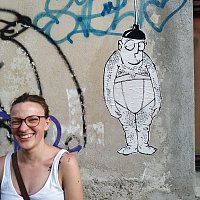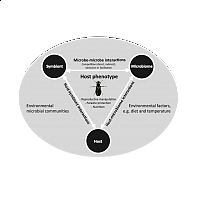Pina Brinker

My interest in science is centred on microbe-microbe and host-microbe interactions and how these interactions affect host phenotypes. Over the first years of my scientific career, I started investigating microbe-host interactions focusing on symbiont-host interactions involving the ant Lasius fuliginosus and symbiotic fungi used in nest building (Brinker et al. 2019 ). During my PhD, I then moved on to investigate how microbe-microbe interactions influence and shape symbiont-induced phenotypes in the system of the parasitic wasp Asobara japonica and the endosymbiont Wolbachia, causing asexual reproduction (https://www.rug.nl/staff/p.brinker/projects ). Especially the latter thought me that the way microbes affect a host can be highly depend on microbe-microbe interactions (Brinker et al. 2019 ).

tripartite interaction
The gut microbiota dimension of honeybee viral spill-over to wild pollinators
To further deepen my understanding of the importance of microbe-microbe interactions for the ecology, evolution and phenotype of a host, I recently started a post-doc project in which I will investigate the bacterial community's role in bumblebees affected by viral spillover from honeybees.
Together with Simon Tragust and in collaboration with Robert Paxton, and Oliver Schweiger , I will investigate if the bacterial community can provide protection against the virus, similar to what has been found in honeybees (Dosch et al., 2021). Next, the project will try to target bacterial players underlying these effects. And finally, we want to see how environmental stressors, such as agrochemicals, will influence these interactions. The project is funded by the state Saxony-Anhalt to support integrative Biodiversity Research between the Martin-Luther University Halle Wittenberg and the Centre for Integrative Biodiversity Research, iDiv (MLU|BioDivFund).

Future students
I'm always looking forward to working with students and helping them to develop their scientific potential further. So, please contact me if you are interested in doing a project with me. I am happy to discuss ideas within the framework of my project or propose existing projects to you that we can develop further together. Supervision is in German or English.
Publications
Streicher, T., Brinker, P., Tragust, S. and Paxton, R. J. (2024) Host Barriers Limit Viral Spread in a Spillover Host: A Study of Deformed Wing Virus in the Bumblebee Bombus terrestris. Viruses 16(4): 607. DOI: 10.3390/v16040607
, , , , , & (2022). Microbiome composition is shaped by geography and population structure in the parasitic wasp Asobara japonica, but not in the presence of the endosymbiont Wolbachia. Molecular Ecology, 00, 1– 15. https://doi.org/10.1111/mec.16699
Tragust, S., Brinker, P., Rossel, N., & Otti, O. (2020). Balancing life history investment decisions in founding ant queens. Frontiers in Ecology and Evolution, 8, 76. https://doi.org/10.3389/fevo.2020.00076
Brinker, P., Fontaine, M. C., Beukeboom, L. W., & Salles, J. F. (2019). Host, symbionts, and the microbiome: the missing tripartite interaction. Trends in Microbiology, 27(6), 480-488. https://doi.org/10.1016/j.tim.2019.02.002
Brinker, P., Weig, A., Rambold, G., Feldhaar, H., & Tragust, S. (2019). Microbial community composition of nest-carton and adjoining soil of the ant Lasius fuliginosus and the role of host secretions in structuring microbial communities. Fungal Ecology, 38, 44-53. https://doi.org/10.1016/j.funeco.2018.08.007
Other
Invited talk at the MiVEGEC Seminar (16/02/23):
"Complex intercations in a host-symbiont-microbiome triangle : The wasp Asobara japonica, the endosymbiont Wolbachia and the remainder microbiome"
Interview with Science on how squash bug young locate a critical bacterium, a recent publication in Current Biology. (2023)
Available scripts & Data
Scripts/Data to the publication: Microbiome composition is shaped by geography and population structure in the parasitic wasp Asobara japonica, but not in the presence of the endosymbiont Wolbachia

